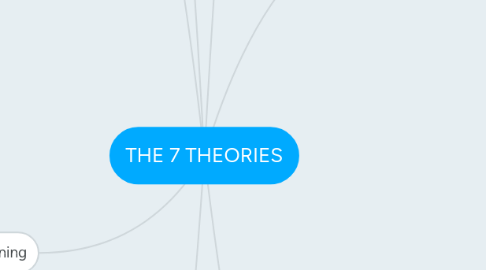
1. Theory of Multiple Intelligences
1.1. Three main factors
1.1.1. Biological endowment
1.1.2. Personal life history
1.1.3. Cultural & historical background
1.2. Key Features
1.2.1. Definition of Intelligence Based on Real-World Intelligence
1.2.2. A Pluralistic View of Intelligence
1.2.3. All Eight Intelligences Are Universal
1.2.4. Intelligences are Educable
1.2.5. Individuals Possess Unique Profiles of Intelligence That Develop and Change
1.3. Thomas Armstrong’s wording
1.3.1. Smarts
1.3.1.1. Work
1.3.1.2. Smart
1.3.1.3. Picture
1.3.1.4. Number
1.3.1.5. Body
1.3.1.6. Music
1.3.1.7. Self
1.3.1.8. People
1.3.1.9. Nature
1.4. Three main ways be used by edctors
1.4.1. Approaching a concept, subject matter
1.4.2. Promoting desired capabilities & talents in students
1.4.3. Personalizing education
2. Experiential Learning
2.1. Key Features
2.1.1. Focus is on direct, pratical experience
2.1.2. Focus on students
2.1.3. Learning is active and interactive
2.1.4. Learning in mistakes
2.1.5. Learning in the real world
2.2. A central feature
2.2.1. Relection
2.2.1.1. Plan- Do- Review
2.3. Common Ecperiential Learning Strategies
2.3.1. Action learing
2.3.1.1. Group wrok to solve the problem
2.3.2. Learning Game
2.3.2.1. Build up a task in the group wrok
2.3.2.2. Using game in classroom
2.3.3. In-class
2.3.3.1. Do some group works e.g role play
2.3.4. out-of-class
2.3.4.1. Intership
2.3.4.2. Learning Trips
2.4. Six dimensions model
2.4.1. Outer work
2.4.1.1. The learing evironmnet
2.4.1.2. Learing in activities
2.4.2. Senses
2.4.2.1. The senese
2.4.3. Inner work
2.4.3.1. Emotion in learning
2.4.3.2. Reason and Intelligence
2.4.3.3. Learning and Change
3. Motivational Theories and Emotion and Learning
3.1. Intrinsic motivation learner
3.1.1. To understand
3.1.2. To be curious
3.1.3. To enjoy
3.1.4. To have energy
3.1.5. Be able to see the new things
3.2. Intrinsic ( Comes from within a person )
3.2.1. Autonomy
3.2.2. Curiosity
3.2.3. Meaning
3.2.4. Learning
3.3. Extrinsic ( Comes from outside forces )
3.3.1. Badges
3.3.2. Competition
3.3.3. Fear of faliure
3.3.4. Fear of punsishment
3.3.5. Rewards
3.4. The improvement of Motivation
3.4.1. Rewards
3.4.2. Praise
3.4.3. Privileges
3.4.4. Social recognition
3.4.5. Obligation Removal
3.5. Cognitive Theories of Motivation
3.5.1. Focus on students
3.5.1.1. Thoughts
3.5.1.2. Beliefs
3.5.1.3. Expectations
3.5.1.4. Attitudes
3.5.2. Intrinsic is important than extrinsic
3.5.3. Interest theory
3.5.4. Goa theory
3.5.5. Self-determination theory
4. Learning Styles
4.1. Models
4.1.1. Honey-Mumford Model
4.1.1.1. Doing
4.1.1.2. Thinking
4.1.1.3. Feeling
4.1.1.4. Observing
4.1.2. Neuro-Linguis2c Programming
4.1.2.1. Visual
4.1.2.2. Auditory
4.1.2.3. Kinaesthetic
4.2. Classroom Application
4.2.1. Find out
4.2.2. Subgroup
4.2.3. Explain
4.2.4. Use
5. Behaviourist Approaches to Learning
5.1. Behavioral Learning Theory
5.1.1. 1.Stimulus (S) Input
5.1.2. 2.Organism (O)
5.1.3. 3.Response (R) Output
5.2. Behaviorism
5.2.1. Two forms of condtioning emerged
5.2.1.1. Classical Conditioning
5.2.1.2. Operant Conditioning
5.3. Pavlov's Classical Conditioning
5.3.1. Stimuli
5.3.2. Unconditioned Response
5.3.3. Neutral Stimuli
5.3.4. Acquisition
5.3.4.1. Conditioned Stimulus
5.3.5. Extinction
5.3.5.1. Unconditioned Stimulus
5.3.5.2. conditioned stimulus
5.3.6. Spontaneous Recovery
5.3.6.1. conditioned stimulus
5.3.6.2. Conditioned Response
5.4. Skinner's Operant Conditioning
5.4.1. Acquisition and Shaping
5.4.2. Reinforcement in Operant Conditioning
5.4.2.1. Behavior
5.4.2.1.1. Consequence
5.4.2.2. Response
5.4.2.2.1. Rewarding Stimulus Presented
5.4.3. Increase desired behavior
5.4.3.1. Presence of pleasant stimulus
5.4.3.1.1. Positive Reinforcement
5.4.3.2. Presence of unpleasant stimulus
5.4.3.2.1. Negative Reinforcement
6. Cognitive Theories of Learning
6.1. Cognition & Cognitive Concepts
6.1.1. Knowledge
6.1.2. Flexibility
6.1.3. Drive
6.2. Cognitive Learning theory
6.2.1. Information Processing theory
6.2.2. Schema theory
6.3. Key Process involved in Memory
6.3.1. ENCODING →
6.3.1.1. STORAGE →
6.3.1.1.1. RETRIEVAL
6.4. Maintaining Information in Memory
6.4.1. 1.Sensory Memory ↓
6.4.2. 2.Short-term Memory ↓
6.4.3. 3.Long-term Memory
6.4.3.1. Episodic memory
6.4.3.2. Semantic memory
6.4.3.3. Procedural memory
6.5. Information Processing Model
6.5.1. External stimulus →
6.5.1.1. Sensory register ↓
6.5.1.1.1. Initial processing
6.5.1.2. Forgotten
6.6. Cognitive Teaching Strategies in the Classroom
6.6.1. Making learning relevant & activating prior knowledge
6.6.2. Organizing information
7. Constructivist Views of Learning
7.1. Constructivism
7.1.1. Cognitive
7.1.2. Social
7.2. Vygotsky and Social Constructivism
7.2.1. Zone of proximal development
7.2.2. Current knowledge & understanding
7.3. Principles of Constructivist Learning
7.3.1. Encouraging autonomy
7.3.2. Asking thought-provoking, open ended & higher-order questions
7.3.3. Checking students’ understanding of concepts
7.3.4. Challenging students’ thinking, ideas & assumptions
7.3.5. Engaging students in meaningful & relevant problem-solving
7.4. Constructivist Approaches to Teaching
7.4.1. Top-Down Processing
7.4.2. Cooperative & Collaborative learning
7.4.3. Discovery learning
7.5. Five Elements of Cooperative Learning
7.5.1. 1. Positive interdependence
7.5.2. 2. Face-to-face promotive interaction
7.5.3. 3. Individual & team accountability
7.5.4. 4. Interpersonal & small team skills
7.5.5. 5. Team processing

